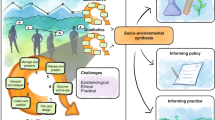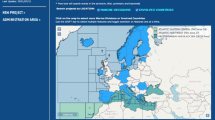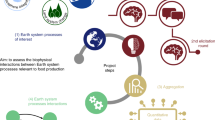Abstract
Echo chambers in science describe the amplification and repetition of information within closed networks. Frequently used data sources can cause echo chambers as scientists keep reading similar outputs from different sources, creating false perceptions of certainty and variety of data sources. We show this effect by studying the scientific and grey literature on water use by electricity systems. The power sector is the largest contributor to anthropogenic carbon emissions and the second largest water consumer. We have assessed the scope and references of 2,426 papers and created a citation network to trace original data sources. Most data sources used for the last 30 years originate from a few old US publications, recently also Chinese, that echo through publications. This echo effect, also reflected in recent scientific publications, creates a confirmation bias, also facilitating double counting of the water intensities of electricity generation. This example from sustainability science warns of the risk of echo chambers in other scientific disciplines.
This is a preview of subscription content, access via your institution
Access options
Access Nature and 54 other Nature Portfolio journals
Get Nature+, our best-value online-access subscription
$29.99 / 30 days
cancel any time
Subscribe to this journal
Receive 12 digital issues and online access to articles
$119.00 per year
only $9.92 per issue
Buy this article
- Purchase on Springer Link
- Instant access to full article PDF
Prices may be subject to local taxes which are calculated during checkout





Similar content being viewed by others
Data availability
All datasets that support the findings of this study are publicly available, or available from the corresponding author upon reasonable request.
References
IPCC: Summary for Policy Makers. In Climate Change 2014: Mitigation of Climate Change (eds Edenhofer, O. et al.) 1–31 (Cambridge Univ. Press, 2014); https://doi.org/10.1017/CBO9781107415324
IEA Clean Energy Transitions Programme (CETP): Annual Report 2018 (OECD Publications, 2019).
Urban, J. J. Emerging scientific and engineering opportunities within the water-energy nexus. Joule 1, 665–688 (2017).
Gerbens-Leenes, P. W., Hoekstra, A. Y. & van der Meer, T. H. The water footprint of bioenergy. Proc. Natl Acad. Sci. USA 106, 10219–10223 (2009).
Mathioudakis, V., Gerbens-Leenes, P. W., Van der Meer, T. H. H. & Hoekstra, A. Y. The water footprint of second-generation bioenergy: a comparison of biomass feedstocks and conversion techniques. J. Clean. Prod. 148, 571–582 (2017).
Murrant, D., Quinn, A., Chapman, L. & Heaton, C. Water use of the UK thermal electricity generation fleet by 2050: part 2 quantifying the problem. Energy Policy 108, 859–874 (2017).
Smith, P. et al. Biophysical and economic limits to negative CO2 emissions. Nat. Clim. Change 6, 42–50 (2016).
Mekonnen, M. M., Gerbens-Leenes, P. W. & Hoekstra, A. Y. Future electricity: the challenge of reducing both carbon and water footprint. Sci. Total Environ. 569, 1282–1288 (2016).
Barberá, P., Jost, J. T., Nagler, J., Tucker, J. A. & Bonneau, R. Tweeting from left to right. Psychol. Sci. 26, 1531–1542 (2015).
Jasny, L., Waggle, J. & Fisher, D. R. An empirical examination of echo chambers in US climate policy networks. Nat. Clim. Change 5, 782–786 (2015).
Choi, D., Chun, S., Oh, H., Han, J. & Kwon, T. “Taekyoung”. Rumor propagation is amplified by echo chambers in social media. Sci. Rep. 10, 310 (2020).
Farrell, J. Politics: echo chambers and false certainty. Nat. Clim. Change 5, 719–720 (2015).
Energy Demands on Water Resources: Report to Congress on the Interdependency of Energy and Water (US Department of Energy, 2006).
Mekonnen, M. M., Gerbens-Leenes, P. W. & Hoekstra, A. Y. The consumptive water footprint of electricity and heat: a global assessment. Environ. Sci. Water Res. Technol. 1, 285–297 (2015).
Vaca-Jiménez, S., Gerbens-Leenes, P. W. & Nonhebel, S. The water footprint of electricity in Ecuador: technology and fuel variation indicate pathways towards water-efficient electricity mixes. Water Resour. Ind. 22, 100112 (2019).
Vaca-Jiménez, S., Gerbens-Leenes, P. W. & Nonhebel, S. Water-electricity nexus in Ecuador: the dynamics of the electricity’s blue water footprint. Sci. Total Environ. 696, 133959 (2019).
Water Use for Electric Power Generation (EPRI, 2008).
Liu, J. et al. Nexus approaches to global sustainable development. Nat. Sustain. 1, 466–476 (2018).
Macknick, J., Newmark, R., Heath, G. & Hallett, K. C. Operational water consumption and withdrawal factors for electricity generating technologies: a review of existing literature. Environ. Res. Lett. 7, 045802 (2012).
Macknick, J., Sattler, S., Averyt, K., Clemmer, S. & Rogers, J. The water implications of generating electricity: water use across the United States based on different electricity pathways through 2050. Environ. Res. Lett. 7, 045803 (2012).
Gleick, P. H. Water and energy. Annu. Rev. Energy Environ. 19, 267–299 (1994).
Meldrum, J., Nettles-Anderson, S., Heath, G. & Macknick, J. Life cycle water use for electricity generation: a review and harmonisation of literature estimates. Environ. Res. Lett. 8, 015031 (2013).
IEA World Energy Outlook 2012 33 (OECD Publications, 2012); https://doi.org/10.1787/weo-2012-en
Averyt, K. et al. Freshwater Use by US Power Plants: Electricity’s Thirst for a Precious Resource (Energy and Water in a Warming World Initiative, UCS Publications, 2011).
Hoff, H. Understanding the Nexus. Background Paper for the Bonn 2011 Conference: The Water, Energy and Food Security Nexus 1–52 (Stockholm Environment Institute, 2011).
Sanders, K. T. Critical review: uncharted waters? The future of the electricity-water nexus. Environ. Sci. Technol. 49, 51–66 (2015).
Cooper, D. C. & Sehlke, G. Sustainability and energy development: influences of greenhouse gas emission reduction options on water use in energy production. Environ. Sci. Technol. 46, 3509–3518 (2012).
Larsen, M. A. D. & Drews, M. Water use in electricity generation for water-energy nexus analyses: the European case. Sci. Total Environ. 651, 2044–2058 (2019).
Gold, H., Goldstein, D. J., Probstein, R. F., Shen, J. S. & Yung, D. Water Requirements for Steam-Electric Power Generation and Synthetic Fuel Plants in the Western United States (US EPA, 1977).
Jin, Y., Behrens, P., Tukker, A. & Scherer, L. Water use of electricity technologies: a global meta-analysis. Renew. Sustain. Energy Rev. 115, 109391 (2019).
Gleick, P. H. Water in Crisis: A Guide to the World’s Fresh Water Resource (Oxford Univ. Press, 1993).
Inhaber, H. Water use in renewable and conventional electricity production. Energy Sources 26, 309–322 (2004).
Spang, E. S., Moomaw, W. R., Gallagher, K. S., Kirshen, P. H. & Marks, D. H. The water consumption of energy production: an international comparison. Environ. Res. Lett. 9, 105002 (2014).
Jornada, D. & Leon, V. J. Robustness methodology to aid multiobjective decision making in the electricity generation capacity expansion problem to minimise cost and water withdrawal. Appl. Energy 162, 1089–1108 (2016).
Geels, F. W. & Kemp, R. Dynamics in socio-technical systems: typology of change processes and contrasting case studies. Technol. Soc. 29, 441–455 (2007).
Rio Carrillo, A. M. & Frei, C. Water: a key resource in energy production. Energy Policy 37, 4303–4312 (2009).
Fthenakis, V. & Kim, H. C. Life-cycle uses of water in US electricity generation. Renew. Sustain. Energy Rev. 14, 2039–2048 (2010).
Davies, E. G. R., Kyle, P. & Edmonds, J. A. An integrated assessment of global and regional water demands for electricity generation to 2095. Adv. Water Resour. 52, 296–313 (2013).
Ali, B. & Kumar, A. Development of life cycle water-demand coefficients for coal-based power generation technologies. Energy Convers. Manag. 90, 247–260 (2015).
Zhang, C., Zhong, L., Fu, X., Wang, J. & Wu, Z. Revealing water stress by the thermal power industry in China based on a high spatial resolution water withdrawal and consumption inventory. Environ. Sci. Technol. 50, 1642–1652 (2016).
Jiang, D. & Ramaswami, A. The ‘thirsty’ water-electricity nexus: field data on the scale and seasonality of thermoelectric power generation’s water intensity in China. Environ. Res. Lett. 10, 024015 (2015).
Srinivasan, S. et al. Water for electricity in India: a multi-model study of future challenges and linkages to climate change mitigation. Appl. Energy 210, 673–684 (2018).
Kyle, P. et al. Influence of climate change mitigation technology on global demands of water for electricity generation. Int. J. Greenh. Gas. Control 13, 112–123 (2013).
Ali, B. The cost of conserved water for coal power generation with carbon capture and storage in Alberta, Canada. Energy Convers. Manag. 158, 387–399 (2018).
Hardy, L., Garrido, A. & Juana, L. Evaluation of Spain’s water-energy nexus. Int. J. Water Resour. Dev. 28, 151–170 (2012).
Linares, P., Sáenz & Sáenz de Miera, G. Implications for Water of the World Energy Scenarios (Economics for Energy, 2010).
Water & Sustainability (Volume 3): US Water Consumption for Power Production - The Next Half Century (EPRI, 2002).
Peer, R. A. M. & Sanders, K. T. Characterising cooling water source and usage patterns across US thermoelectric power plants: a comprehensive assessment of self-reported cooling water data. Environ. Res. Lett. 11, 124030 (2016).
Luderer, G. et al. Description of the REMIND Model (Version 1.6). SSRN Electron. J. https://doi.org/10.2139/ssrn.2697070 (2015).
Gleick, P. H. Environmental consequences of hydroelectric development: the role of facility size and type. Energy 17, 735–747 (1992).
Mekonnen, M. M. & Hoekstra, A. Y. The blue water footprint of electricity from hydropower. Hydrol. Earth Syst. Sci. 16, 179–187 (2012).
Grubert, E. & Sanders, K. T. Water use in the United States energy system: a national assessment and unit process inventory of water consumption and withdrawals. Environ. Sci. Technol. 52, 6695–6703 (2018).
Grubert, E., Rogers, E. & Sanders, K. T. Consistent terminology and reporting are needed to describe water quantity use. J. Water Resour. Plan. Manag. 146, 04020064 (2020).
Albrecht, T. R., Crootof, A. & Scott, C. A.The water-energy-food nexus: a systematic review of methods for nexus assessment. Environ. Res. Lett. 13, 043002 (2018).
Newell, J. P., Goldstein, B. & Foster, A. A 40-year review of food-energy-water nexus literature and its application to the urban scale. Environ. Res. Lett. 14, 073003 (2019).
Liu, L. & Mei, S. Visualising the GVC research: a co-occurrence network based bibliometric analysis. Scientometrics 109, 953–977 (2016).
Schiebel, E. Visualization of research fronts and knowledge bases by three-dimensional areal densities of bibliographically coupled publications and co-citations. Scientometrics 91, 557–566 (2012).
Macknick, J., Newmark, R., Heath, G. & Hallett, K. C. A Review of Operational Water Consumption and Withdrawal Factors for Electricity Generating Technologies (NREL, 2011).
Zhong, S., Geng, Y., Liu, W., Gao, C. & Chen, W. A bibliometric review on natural resource accounting during 1995–2014. J. Clean. Prod. 139, 122–132 (2016).
Fornito, A., Zalesky, A. & Bullmore, E. T. in Fundamentals of Brain Network Analysis (eds Fornito, A. et al.) 115–136 (Elsevier, 2016); https://doi.org/10.1016/B978-0-12-407908-3.00004-2
MATLAB. version 9.7.0 (R2019b). (The MathWorks Inc., 2019).
Okadera, T., Chontanawat, J. & Gheewala, S. H. Water footprint for energy production and supply in Thailand. Energy 77, 49–56 (2014).
Del Vicario, M. et al. The spreading of misinformation online. Proc. Natl Acad. Sci. USA 113, 554–559 (2016).
Acknowledgements
We thank Y. Shan, M. Mengdie and D. Zhao for helping us assess the characteristics and quality of the Chinese data sources. This work was supported by SENESCYT (National Secretariat of Higher Education, Science, Technology and Innovation of Ecuador).
Author information
Authors and Affiliations
Contributions
S.V.-J. performed data analysis and wrote the paper. P.W.G.-L. conceptually designed the study and edited the paper. S.N. and K.H. supervised the project and provided an outline for the paper and edited it.
Corresponding author
Ethics declarations
Competing interests
The authors declare no competing interests.
Additional information
Peer review information Nature Sustainability thanks Lu Liu, Kelly Sanders and the other, anonymous, reviewer(s) for their contribution to the peer review of this work.
Publisher’s note Springer Nature remains neutral with regard to jurisdictional claims in published maps and institutional affiliations.
Supplementary information
Supplementary Information
Supplementary Methods, Discussion, Notes 1–8, Figs. 1–19 and references.
Rights and permissions
About this article
Cite this article
Vaca-Jiménez, S., Gerbens-Leenes, P.W., Nonhebel, S. et al. Unreflective use of old data sources produced echo chambers in the water–electricity nexus. Nat Sustain 4, 537–546 (2021). https://doi.org/10.1038/s41893-021-00686-7
Received:
Accepted:
Published:
Issue Date:
DOI: https://doi.org/10.1038/s41893-021-00686-7



